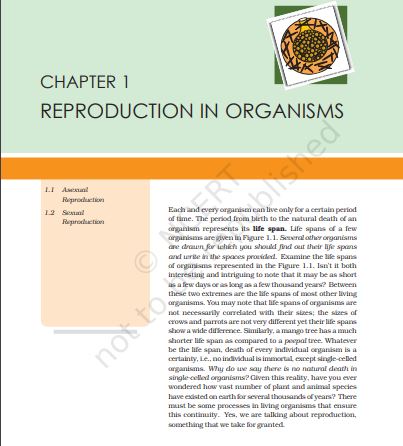‘NCERT Solutions for Class 12 Biology Chapter 1‘ PDF Quick download link is given at the bottom of this article. You can see the PDF demo, size of the PDF, page numbers, and direct download Free PDF of ‘Ncert Class 12 Biology Chapter 1 Exercise Solution’ using the download button.
NCERT Class 12 Biology Textbook Chapter 1 With Answer PDF Free Download

Chapter 1: Reproduction In Organisms
Each and every organism can live only for a certain period of time. The period from birth to the natural death of an organism represents its life span. The life spans of a few organisms are given in Figure 1.1.
Several other organisms are drawn for which you should find out their life spans and write in the spaces provided.
Examine the life spans of organisms represented in Figure 1.1. Isn’t it both interesting and intriguing to note that it may be as short as a few days or as long as a few thousand years?
Between these two extremes are the life spans of most other living organisms. You may note that the life spans of organisms are not necessarily correlated with their sizes; the sizes of crows and parrots are not very different yet their life spans show a wide difference.
Similarly, a mango tree has a much shorter life span as compared to a peepal tree. Whatever be the life span, the death of every individual organism is a certainty, i.e., no individual is immortal, except single-celled organisms.
Why do we say there is no natural death in single-celled organisms? Given this reality, have you ever wondered how vast a number of plant and animal species have existed on earth for several thousands of years?
There must be some processes in living organisms that ensure this continuity. Yes, we are talking about reproduction, something that we take for granted.
Reproduction is defined as a biological process in which an organism gives rise to young ones (offspring) similar to itself.
The offspring grow, mature, and in turn, produce new offspring. Thus, there is a cycle of birth, growth, and death.
Reproduction enables the continuity of the species, generation after generation. You will study later in Chapter 5 (Principles of Inheritance and Variation) how genetic variation is created
and inherited during reproduction.
There is a large diversity in the biological world and each organism has evolved its own mechanism to multiply and produce offspring.
The organism’s habitat, its internal physiology, and several other factors are collectively responsible for how it reproduces.
Based on whether there is the participation of one organism or two in the process of reproduction, it is of two types. When offspring is produced by a single parent with or without the involvement of gamete formation, the reproduction is asexual.
When two parents (opposite sex) participate in the reproductive process and also involve the fusion of male and female gametes, it is called sexual reproduction.
| Author | NCERT |
| Language | English |
| No. of Pages | 18 |
| PDF Size | 13 MB |
| Category | Biology |
| Source/Credits | ncert.nic.in |
NCERT Solutions Class 12 Biology Chapter 1 Reproduction In Organisms
1. Why is reproduction essential for organisms?
Solution:
Reproduction is essential for the continuity of species on earth. If the organisms do not reproduce, life will cease to exist.
2. Which mode of reproduction is better: asexual or sexual? Why?
Solution:
Sexual reproduction is better than asexual reproduction because it produces offspring that are genetically unique from the parents. It also means that the offspring will be more resilient and be able to survive better than either parent due to genetic variation.
3. Why is the offspring formed by asexual reproduction referred to as clones?
Solution:
The offsprings formed by asexual reproduction are referred to as clones because it involves only a single parent. Furthermore, there is no recombination of genes and the offspring produced are genetically identical.
4. Offsprings formed due to sexual reproduction have better chances of survival. Why? Is this statement always true?
Solution:
Sexual reproduction is said to occur when two gametes fuse. This leads to the production of the offspring that are genetic variants of the parents and therefore, are able to survive better.
However, the organisms produced by sexual reproduction do not always survive more than those produced by asexual reproduction. Sometimes, the organisms produced by asexual reproduction survive better than those produced by sexual reproduction. Also, it is a fairly quick process and consumes less energy and time.
5. How does the progeny formed from asexual reproduction differ from those formed by sexual reproduction?
Solution:
The progeny formed by asexual reproduction involves a single parent and is genetically identical to the parent whereas the progeny formed by sexual reproduction are formed when male and female gametes fuse together and are genetically unique.
Reproduction In Organisms NCERT Textbook With Solutions PDF Free Download
